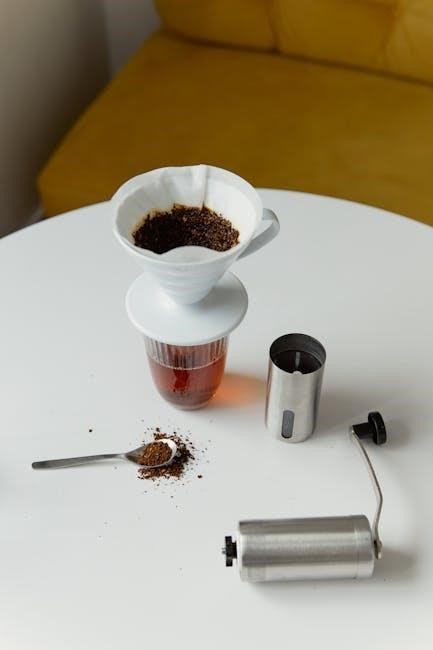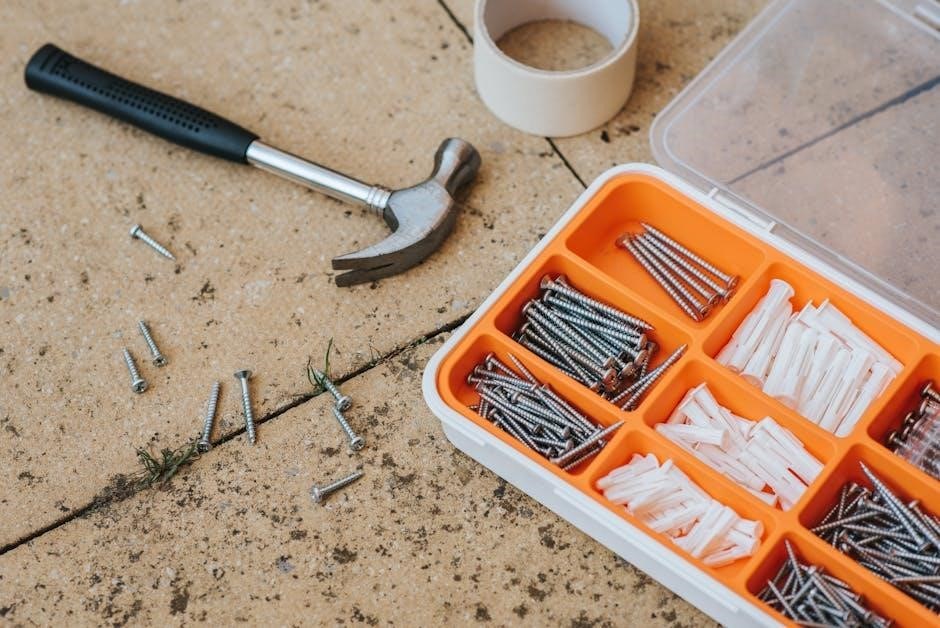Manual surface grinders are machines used for grinding surfaces smoothly, typically with
- variable speed
and
- table movement
for precise control, ensuring accurate results in various industrial applications always.
Definition and Purpose
A manual surface grinder is a type of machine tool used to grind and finish surfaces to a high degree of precision and accuracy, with the primary purpose of achieving smooth surfaces and precise dimensions. The machine consists of a grinding wheel, a table, and a system of ways and bearings that enable precise movement and control. The purpose of a manual surface grinder is to remove small amounts of material from a workpiece, typically a metal part, to achieve a desired surface finish and dimensional accuracy. This is achieved through the use of a rotating grinding wheel, which is brought into contact with the workpiece, and the table, which is moved back and forth to grind the entire surface. The manual surface grinder is an essential tool in many industries, including manufacturing, aerospace, and automotive. It is used to grind and finish a wide range of parts and components.
Importance in Industry
Manual surface grinders play a crucial role in various industries, including manufacturing, aerospace, and automotive, where precision and accuracy are essential. The use of manual surface grinders enables companies to produce high-quality parts and components with precise dimensions and smooth surfaces. This is particularly important in industries where safety and reliability are critical, such as in the production of aircraft and automotive parts. Manual surface grinders are also used in the production of medical equipment, precision instruments, and other high-precision devices. The importance of manual surface grinders in industry cannot be overstated, as they provide a cost-effective and efficient means of achieving high-quality surface finishes and precise dimensions, which is essential for ensuring the reliability and performance of critical components. The use of manual surface grinders has become a standard practice in many industries, and their importance continues to grow.

Types of Manual Surface Grinders
Manual surface grinders include hand feed and hydraulic types, each with unique features and applications always used for grinding surfaces smoothly and accurately every time with precision.
Hand Feed Grinders
Hand feed grinders are a type of manual surface grinder that requires the operator to manually move the table and control the grinding process. They are typically used for small to medium-sized workpieces and are often preferred for their simplicity and ease of use. The hand feed grinder features a manual table movement system, which allows the operator to precisely control the grinding process. This type of grinder is commonly used in precision grinding applications where high accuracy and precision are required. The hand feed grinder is also often used in toolroom and maintenance applications where a high degree of flexibility and control are needed. With their manual operation, hand feed grinders provide a cost-effective solution for precision grinding needs, and are widely used in various industries, including manufacturing and engineering, to produce high-quality products. They offer versatility and ease of operation.
Hydraulic Feed Grinders
Hydraulic feed grinders are a type of manual surface grinder that utilizes a hydraulic system to control the table movement and grinding process. The hydraulic feed grinder features a smooth and consistent table movement, allowing for precise control over the grinding process. This type of grinder is commonly used for heavy-duty grinding applications where high productivity and efficiency are required. The hydraulic feed grinder is also often used in high-volume production environments where consistency and reliability are crucial. With their hydraulic operation, these grinders provide a high degree of accuracy and precision, making them ideal for grinding large and complex workpieces. They offer improved productivity and efficiency, and are widely used in various industries, including manufacturing and engineering, to produce high-quality products with complex geometries and precise tolerances, ensuring consistent results and minimizing errors. They are reliable and efficient machines.

Components and Features
Manual surface grinders have various
- key components
and features, including tables and drives, for optimal performance always.
Table and Ways
The table and ways are critical components of a manual surface grinder, providing a stable and precise platform for grinding operations. The table is typically made of high-quality cast iron or steel, ensuring durability and resistance to wear and tear. The ways, on the other hand, are designed to guide the table’s movement, allowing for smooth and accurate grinding. According to the manual, the table runs on steel halls in hardened and ground steel ways, making it easier to operate than conventional surface grinders. This design enables the manual surface grinder to achieve high levels of accuracy and precision, making it an essential tool in various industrial applications. The table’s movement is controlled by hand wheels, allowing operators to precisely position the workpiece for grinding. Overall, the table and ways play a vital role in the manual surface grinder’s ability to deliver high-quality grinding results.
Drive Systems
Manual surface grinders are equipped with drive systems that enable the table to move smoothly and accurately. The drive system typically consists of a motor, gearbox, and spindle, which work together to provide the necessary power and control for grinding operations. According to the manual, Sharps manual surface grinders use steel core wire rope table drives, ensuring smooth table movement and precise control. This design allows for variable speed and table movement, enabling operators to adjust the grinding process to suit specific application requirements. The drive system is designed to provide consistent and reliable performance, making it an essential component of the manual surface grinder. With its robust construction and precise control, the drive system enables manual surface grinders to deliver high-quality grinding results in a variety of industrial applications, including metalworking and manufacturing. The drive system is a critical component of the manual surface grinder.

Operations and Maintenance
Manual surface grinders require regular maintenance and proper operation for optimal performance and longevity always using correct procedures.
Unloading and Safety Instructions
Manual surface grinders come with specific unloading and safety instructions to ensure safe handling and operation. The instructions emphasize the importance of proper personal protective equipment, such as gloves and safety glasses. Operators must also follow guidelines for unloading the machine, including disconnecting power sources and securing loose parts. Additionally, the instructions outline safety precautions for avoiding accidents and injuries, such as keeping loose clothing tied back and long hair tied away from the machine. By following these instructions, operators can minimize risks and ensure a safe working environment. The safety instructions are typically provided in the machine’s manual, which should be read and understood before operating the grinder. These instructions are crucial for preventing accidents and ensuring the longevity of the machine. Regular review of these instructions is also recommended to maintain a safe working environment.
Maintenance and Repair
Regular maintenance is essential for extending the life of a manual surface grinder. This includes checking and replacing worn-out parts, such as grinding wheels and table ways. The machine’s manual provides a schedule for routine maintenance tasks, such as lubricating moving parts and cleaning the machine. Repairing the grinder requires attention to detail and adherence to safety protocols. Operators should refer to the machine’s manual for troubleshooting guides and repair instructions. Additionally, manufacturer-approved replacement parts should be used to ensure compatibility and maintain the machine’s performance. By following a regular maintenance routine and addressing repairs promptly, operators can minimize downtime and ensure the grinder continues to perform accurately and efficiently. Proper maintenance and repair practices also help prevent accidents and injuries, making them a critical aspect of operating a manual surface grinder. Regular maintenance is crucial for optimal performance.

Specifications and Accuracy
Manual surface grinders have precise specifications and accuracy requirements always met with proper calibration and maintenance procedures in place for optimal performance and results always.
Accuracy and Tolerances
Manual surface grinders are designed to achieve high accuracy and precise tolerances, typically within 0.0001-0;0002 inches, making them suitable for various industrial applications. The machines’ ability to maintain such tight tolerances is due to their robust construction and precise movement of the table and grinding wheel. The accuracy of manual surface grinders is also influenced by the quality of the grinding wheel, the condition of the machine’s ways, and the operator’s skill level. To ensure optimal accuracy, it is essential to regularly calibrate and maintain the machine, as well as follow proper operating procedures. By doing so, manual surface grinders can consistently produce high-quality results, meeting the required specifications and tolerances. This level of accuracy is crucial in many industries, including aerospace, automotive, and medical device manufacturing, where precision is paramount. Regular maintenance is necessary to maintain accuracy.
Machine Specifications
Manual surface grinders have various specifications that define their capabilities and suitability for different applications. The table size, grinding wheel diameter, and spindle power are key specifications that determine the machine’s capacity and performance. Other important specifications include the table travel, cross-feed range, and wheel speed. These specifications are usually provided by the manufacturer and can be found in the machine’s manual or technical documentation. The specifications of manual surface grinders can vary widely, depending on the intended use and industry. For example, a grinder designed for heavy-duty industrial use may have a larger table and more powerful spindle than one intended for precision grinding in a laboratory setting. Understanding the machine specifications is essential for selecting the right grinder for a particular application and ensuring optimal performance. Manufacturers provide detailed specifications for each model, including technical data and operating parameters.
